The global pandemic sparked an IT revolution, addressing supply-chain disruptions, procurement issues, and employee expectations. This transformation has not only reshaped business processes but also driven the digital workplace market to a revenue of US$40 billion in 2023, as Market.us reports.
However, Gartner predicts that by 2027, 85% of workload placements from before 2022 will become outdated due to evolving requirements. Therefore, both SMEs and large corporations need to closely monitor emerging trends to remain competitive and technologically advanced.
Understanding the critical role of adaptability in maintaining productivity and relevance, we have curated this guide. It aims to help you navigate the 2024 digital workplace trends, craft effective strategies, and ensure employee satisfaction.
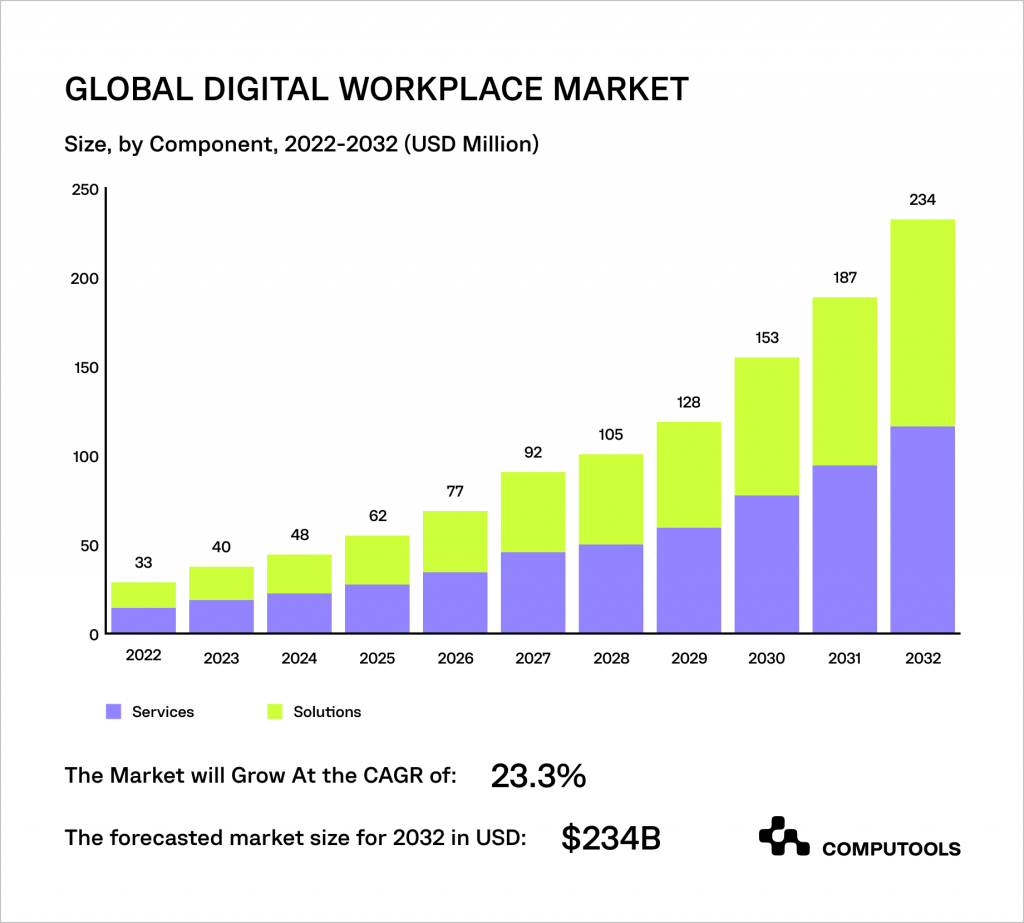
Why Digital Workplace Is Now Standard for Businesses
Businesses are adopting digital workplaces as the standard for several key reasons that reflect the changes in technology, work culture, and global business needs.
1. Technology drives change
Advancements in technology are reshaping the way we work. With fast internet available almost everywhere, employees can now work remotely and stay connected with ease.
Additionally, cloud computing services provide enterprises with the flexibility to adapt quickly to changes without the need for costly physical infrastructure.
2. Workforce expectations have evolved
Employees desire work-life balance, seeking flexible work hours and locations. The new generation of digital natives entering the workforce expects digital workplace tools to be as integrated and advanced as the tech they use in their personal lives.
3. Ensuring business continuity
As globalisation continues to progress, businesses are faced with the challenge of meeting global demands.
This means not only catering to diverse markets but also coordinating activities across various time zones. By bridging geographical divides, companies can tap into their global workforce’s collective expertise and resources.
4. Meeting security standards
Digital workplace solutions provide stronger security measures compared to traditional setups. They can be designed to meet data protection laws, ensuring sensitive information is handled safely.
Technologies like Zero Trust Network Access (ZTNA) allow employees to securely access networks from any device, anywhere, providing enhanced protection against cyber threats.
10 Digital Workplace Trends For 2024
1. Artificial Intelligence
Artificial Intelligence (AI) is quickly reshaping traditional work processes. AI-driven automation of mundane administrative tasks allows employees to sharpen their soft skills, fundamentally changing the nature of work.
McKinsey reports that AI significantly impacts the workplace by automating repetitive tasks (24%) and improving strategies and customer-focused products (19%).
Overall, AI and machine learning substantially influence transforming work environments and maintaining businesses’ competitiveness; this trend is expected to persist for a considerable period.

2. Everything as a Service (XaaS)
Companies are more and more choosing asset-light or asset-free business models, subscribing to services to avoid significant initial investments. This strategy lowers capital expenses and raises operational expenses, providing more flexibility and scalability.
The Everything as a Service (XaaS) approach offers digital workplace solutions through subscriptions. This method simplifies budgeting and cuts down the total cost of ownership for companies.
By adopting the XaaS model, businesses concentrate on their primary skills while benefiting from the latest digital workplace solutions without hefty upfront costs.
3. Mobile Apps
The rising demand for mobile app functionality in digital workplaces is hardly surprising because they serve as the central communication hub and main entry point to the digital workplace.
As the trend of Bring Your Own Device (BYOD) becomes more prevalent in workplaces, the importance of mobile access is expected to grow even further.
Employees benefit from mobile apps by getting immediate alerts (push notifications) for important updates directly on their phones, accessing contact details and key data remotely, submitting job-related information like timesheets, and using self-service features, including schedules and forms.
4. Digital Employee Experience
Digital workplaces have often suffered from disjointed employee experiences and options, leaving employees, especially those on the front lines, feeling isolated and unsupported.
Organisations are now prioritising the creation of a unified and accessible digital workplace system that enhances the digital employee experience (DEX) across all roles and levels.
Many enterprises are dedicating resources to developing central communication hubs. These hubs offer employees easy access to wellness support, eLearning training modules, policies, procedures, and other necessary data for completing their tasks.
These solutions connect to other systems and tools through single sign-on capabilities, seamlessly integrating and aggregating key data from third-party systems into one central location, fostering a cohesive experience and a positive workplace culture, regardless of a team’s geographical spread.
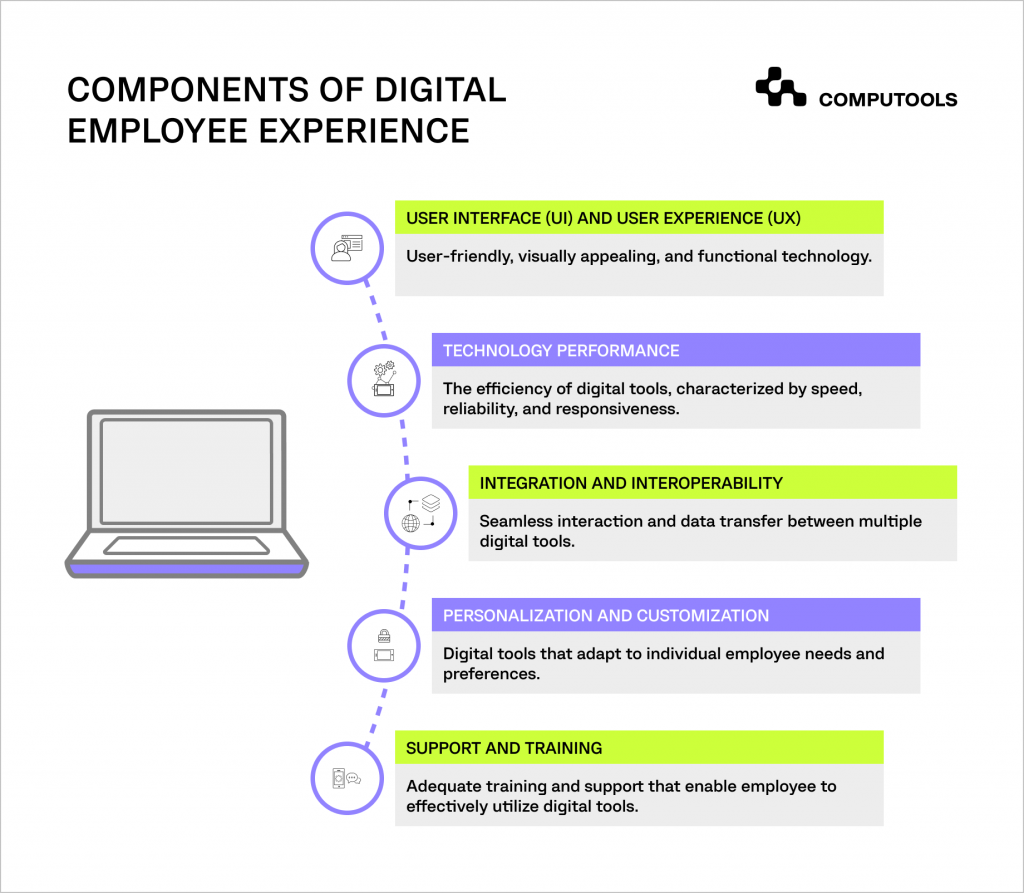
5. ESG Initiatives
Businesses now prefer service providers that prioritise sustainability when adopting digital workplace trends, advancing companies’ Environmental, Social, and Governance (ESG) initiatives.
With careful and strategic implementation, these solutions can cut down on paper use, reduce energy consumption, support sustainable supply chain management, bolster data security and transparency, enhance risk management, and improve reporting processes.
6. Digitalisation and Automation
The shift to remote work has made it clear that enterprises need to abandon manual and paper-based processes, which become cumbersome when employees work from different locations without access to office supplies.
Managing workflows has long been a challenge for many businesses, but they are now widely adopting modern Citizen Automation and Development Platforms (CADPs).
Another major challenge for organisations is the remote onboarding of employees and quickly bringing them up to speed, despite not being physically together.
This is driving more businesses to implement online onboarding portals, complete with eLearning courses, company information links, staff directories, and task checklists, all of which are accessible online at any time for convenience.
7. Strategy and Roadmap Development
For many organisations, the digital workplace has taken over the traditional physical office space completely. As the demand for digital workplace solutions development grows, enterprises must adopt a more strategic and proactive approach to secure their success in the long run.
Creating or refining your workplace demands a solid framework, strategy, and roadmap. Equally important is dedicating ongoing internal resources to governance, ensuring your workplace continues to be effective, central, and pertinent over time.
This investment, though modest, is significant for supporting a piece of IT infrastructure that’s becoming increasingly critical for companies.
8. Data and Security
Modern digital workplaces introduce new risks such as hacking, data breaches, and complex email scams, especially as more employees use their devices for work.
Organisations are enhancing their security measures, implementing two-factor authentication, security tailored for BYOD policies, strict security permissions, compliance requirements, and frequent reminders for password updates.
Companies are also increasingly investing in Managed Detection and Response (MDR), Extended Detection and Response (XDR), and other threat detection technologies to combat the rise in ransomware attacks.
While there’s a keen interest in deploying XDR by the end of 2024, its widespread adoption may be delayed since the XDR market is still developing.
Furthermore, businesses will need to ramp up their efforts in providing resources and training to employees on how to effectively mitigate data and security risks, investing in eLearning and cybersecurity knowledge bases.
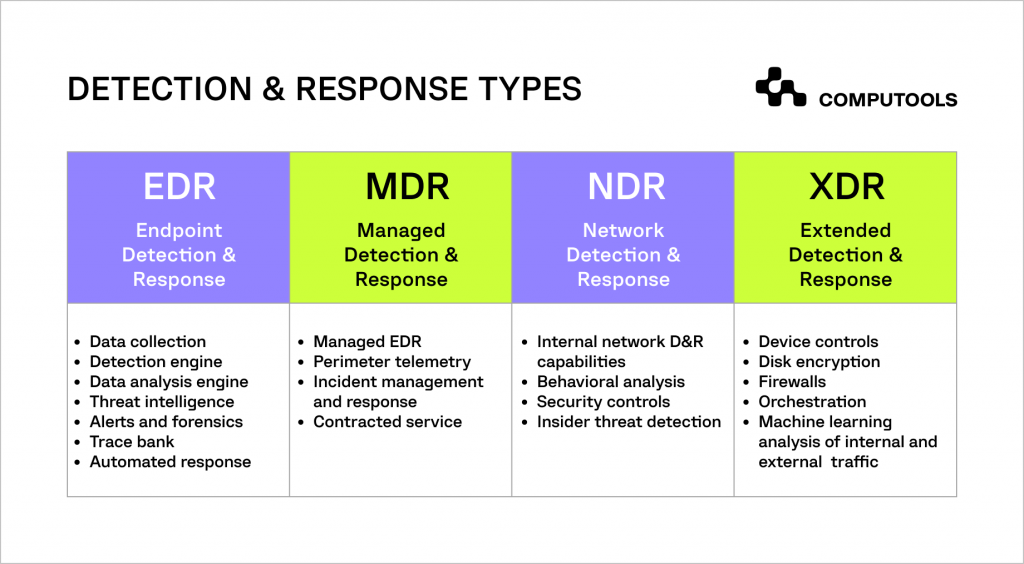
9. Virtual Collaboration
Digital workplace solutions can now substitute nearly all in-person office interactions, including virtual meetings, project workspaces, comprehensive corporate directories, and social forums that serve as modern-day watercooler spots.
Features like screen sharing and file-based collaboration enable team members to work together on projects in real time. Collaboration is, and will remain, a key driver of success in today’s workplaces. In fact, a study showed that companies encouraging collaborative work were five times more likely to be high performers.
10. Hybrid Environments
Large companies are increasingly prioritising strategies to encourage returning to the office. It’s becoming clear that while IT must support remote employees with seamless technology access, it also has to enhance the physical office environment to promote direct interactions, meetings, and teamwork.
This dual focus may lead to the creation of two distinct IT roles or departments, each with its unique set of responsibilities, rather than having a single team manage both.
Ensuring an equitable experience for all employees, regardless of their location, will be a high priority for the companies in 2024 and beyond.
Technologies like end-user computing (EUC) and Unified Communications Collaboration (UCC) will continue to empower those working remotely or in hybrid setups.
Learn how to transform your digital workplace with Computools’ expertise.
Contact us →Predictions for the Future of the Digital Workplace
As the digital transformation accelerates worldwide, our work environments, digital workplace operations, and workflows will continually evolve with information technology.
Here are some predictions from Computools for the coming years.
1. Enterprises will continue investing in Artificial Intelligence (AI), Data Science, and Machine Learning (DSML) platforms to boost the operational efficiency of their infrastructure.
Today, they are already embracing DSML platforms and AI cloud services to enhance the visibility of digital business across on-premises, cloud, and edge computing architectures.
2. The focus on extended (XR) and virtual reality (VR) digital workplace tools for frontline workers is set to increase. While still emerging for in-office use, immersive, augmented, and virtual reality technologies hold considerable potential for non-office workers, especially in industries like manufacturing.
Leaders in global frontline worker management are actively exploring the implementation of these emerging technologies to bolster their workforce.
As a result, the adoption of extended and virtual reality for frontline workers will grow, creating the need for enhanced management and security measures.
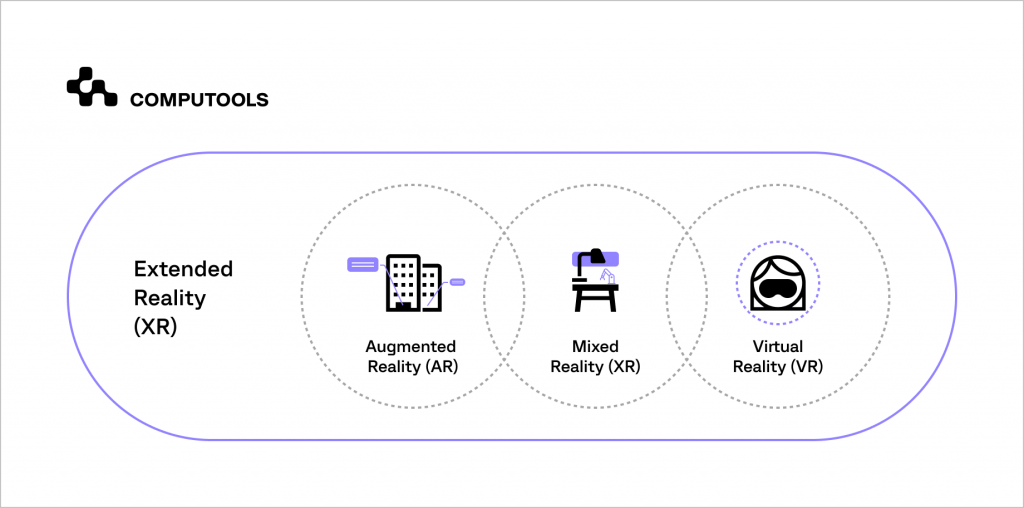
3. Companies will be giving priority to investing in hybrid and remote work environments over tools for productivity. Enterprises are now focusing on rolling out cloud and security technologies to reinforce infrastructure suited for remote and hybrid work settings.
Trends also show a high interest in Distributed Cloud Systems and Hybrid Cloud Storage, leading to their accelerated deployment.
4. Despite planning to adopt Natural Language Processing (NLP) in 2022, enterprises are still trailing in its implementation. Even with significant improvements in NLP technologies, the complexity and ambiguity of human language pose significant hurdles to its widespread adoption, and we won’t see its mass integration soon.
5. Companies are expected to increasingly invest in Platform-as-a-Service (PaaS) to navigate unpredictable API traffic and overcome internal support skill limitations.
The transition to API management PaaS, driven by its robust support for cloud platforms and automation, emerges as a strategic move.
This trend is further fueled by the challenge of finding talent with specialised skills required for API management, pushing businesses towards this more sustainable and efficient approach.
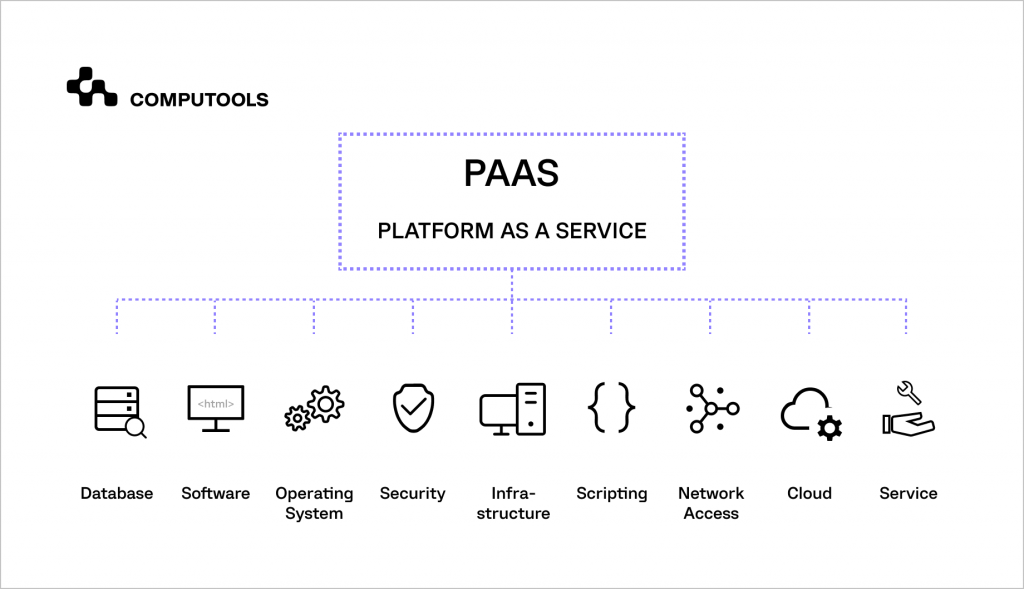
Essential Concepts for Building Your Digital Workspace Strategy
To sum up our guide, we want to give you a list of important terms and concepts that are necessary for creating your digital workplace development strategy. Here are the main points discussed in the article.
1. XaaS (Everything as a Service)
This refers to a cloud computing service enabling users to use various services via the Internet, minimising reliance on local hardware and software.
2. BYOD (Bring Your Own Device)
A policy that allows employees to use their personal devices, like smartphones and laptops, for work purposes.
It’s important to note, however, that it can sometimes be more cost-effective for the company to supply devices rather than rely entirely on BYOD.
In scenarios where the work doesn’t demand a high-performance computer, opting for a budget-friendly laptop may be the better choice, particularly when operations are cloud-based.
3. DEX (Digital Employee Experience)
Covers all digital interactions between an employee and their workplace. A positive DEX can boost productivity and satisfaction by providing seamless technology experiences.
4. CADPs (Citizen Automation and Development Platforms)
These platforms enable non-technical users to automate processes and develop applications, allowing employees to create solutions that improve their work without needing specialised coding skills.
5. MDR (Managed Detection and Response)
A cybersecurity service that provides organisations with threat hunting, monitoring and response solutions.
6. XDR (Extended Detection and Response)
An advanced security solution that provides comprehensive threat detection and response across various data sources, including endpoints, networks and clouds.
7. EUC (End-User Computing)
Focuses on providing users with access to applications and data on any device from anywhere. EUC strategies in digital workplaces can enhance productivity and flexibility while maintaining security and compliance.
8. UCC (Unified Communications Collaboration)
Combines communication tools like email, instant messaging, voice and video conferencing into a single platform. UCC supports collaboration for remote and hybrid work models.
9. DSML (Data Science and Machine Learning)
Involves extracting insights from data using algorithms and machine learning models. Digital workplaces use DSML for predictive analytics, personalised experiences, and process optimisation.
10. NLP (Natural Language Processing)
A branch of AI that enables computers to understand, interpret, and respond to human language. Digital workplaces use NLP in chatbots and voice assistants to automate document processing.
11. PaaS (Platform as a Service)
A cloud computing model that provides a platform allowing customers to develop, run, and manage applications without dealing with the infrastructure.
12. ZTNA (Zero Trust Network Access)
A security model based on the principle of “never trust, always verify.” It secures digital workplaces by asking for verification for every access request to applications or data, regardless of the user’s location. ZTNA supports remote and hybrid work, protecting against unauthorised access and breaches.
Final Thoughts
As the tech environment and worldwide economic conditions evolve, certain trends might shift or lose relevance. Nonetheless, some trends will definitely rise to the forefront of discussions this year and in the future.
Computools stays updated on developments in workplace technology and is ready to guide you through your transformation journey.
Want to jump into the future of the digital workplace? Email us at info@computools.com to learn how to use these trends for your business.









Computools was selected through an RFP process. They were shortlisted and selected from between 5 other suppliers. Computools has worked thoroughly and timely to solve all security issues and launch as agreed. Their expertise is impressive.